Past and Present: The Brown Homestead in Prospect Lefferts Gardens
A look at Brooklyn, then and now. Finding this great photograph of a long-gone mansion in Flatbush was the easy part. Finding out where it was and who the “Brown” mentioned was would turn out to be a bit more difficult. The only name that could possibly be harder to track would be someone named…

A look at Brooklyn, then and now.
Finding this great photograph of a long-gone mansion in Flatbush was the easy part. Finding out where it was and who the “Brown” mentioned was would turn out to be a bit more difficult. The only name that could possibly be harder to track would be someone named “Smith.” There were a lot of Browns in Brooklyn, and since there was no date or address, it took some doing, and a bit of luck. But in the end, the mystery was solved.
The location: The Brown mansion was at 694 Flatbush Avenue, near the corner of Parkside Avenue. Although this neighborhood is now called Prospect Lefferts Gardens, in the 19th century it was just plain old Flatbush.
The Lefferts family homestead was nearby, as were the homes of many of Flatbush’s older families. This was a wealthy area, and also a very desirable one. It was close to public transportation, with Flatbush Avenue the major roadway between the harbor at Fulton Landing and the oceanfront at what is now Floyd Bennett Field.
Flatbush remained an independent town and not part of the City of Brooklyn until 1894. It had its own town government, raised its own money for roads and infrastructure and collected its own taxes. Because much of it remained farmland until the 20th century, Flatbush life was very different that the more urban life on the other side of the park.
But that was changing.
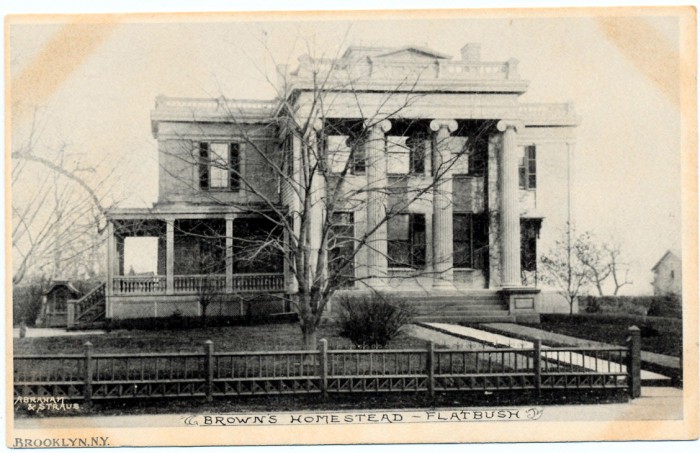
This house and the large property surrounding it belonged to William A. A. Brown. He was a banker, capitalist, real estate developer, avid horticulturist and a big man in Flatbush politics and policy. He was also the head of the Budweiser Brewing Company.
No, not THAT Budweiser, but the Brooklyn Bud.
Brown led a group of investors that purchased the Bedford Brewery in 1884. It was located on Dean Street at Franklin Avenue, where it had been founded in 1849 as the Limburger and Walter Brewery. They brewed German lager beer, and started out small. In 1866, Christian Goertz bought out the founders and renamed it the Bedford Brewery.
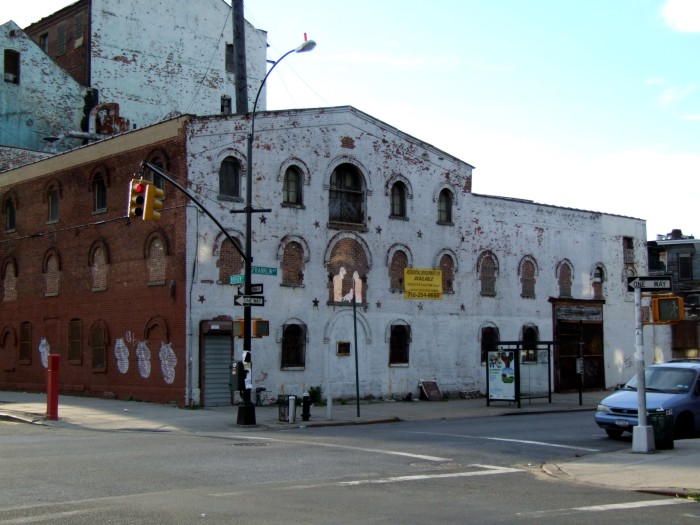
Goertz grew the business substantially, so that by 1879 it was the 10th largest of Brooklyn’s 47 breweries. Brown purchased it with a group of anonymous investors, and it became his baby. He spend a great deal of money upgrading the equipment and constructing new buildings for the plant (pictured above and below). By doing so he was able to triple the brewery’s output in only one year.
William Brown had considerable brewing experience. He had been with T.C. Lyman & Co., a very successful Manhattan ale producer, and then became the president of the Williamsburgh Brewing Company.
Brown wanted to find the recipe for the perfect lager, so he went to Europe on a beer tasting trip. He found the perfect blend of malt and hops in the city of Budweis, in Czechoslovakia, so when he came home, he named his beer and his brewery after the town. Brooklyn’s Budweiser was born.
It would take a while for Anheuser-Busch to catch up with him, but as his market grew, they did. They had already trademarked the name Budweiser in 1876. Brown would later have to change the name to the Nassau Brewery.
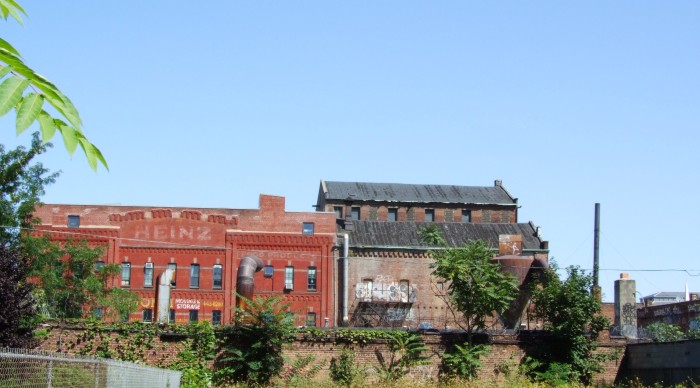
In the meantime, Brown was a busy man. He was a board member of the People’s Trust Bank, he was making real estate development deals in several neighborhoods, and for a while, he was the police commissioner of Flatbush. He was an ardent Democrat, and ran for Congress at one point.
Brown’s name came up often in the press during the latter decades of the 19th century as a fierce advocate for Flatbush. He sat on committees that oversaw the paving of streets, the laying down of sewers and all kinds of other public improvements.
He was a “my way or the highway” kind of guy, and made enemies, but he really did love Flatbush. If only everyone could see his wisdom, seemed to be his view. And as successful as he was, one could understand how he felt that way.
Whether Brown bought the mansion pictured above, whether he built it or whether it was the family manse from another generation is unknown. It sat on the park side of Flatbush Avenue with similar sized houses as neighbors to the north.
Far behind the house was the cut for the Brighton Beach Railroad line that ran to Coney Island. Beyond that was Ocean Avenue. In the latter part of the 19th and on into the 20th century, Ocean Avenue was lined with mansions. The apartment buildings and even the landmarked group of row houses called Ocean on the Park wouldn’t be built until around 1910. The 1905 map below shows how sparse development was at the start of the 20th century.
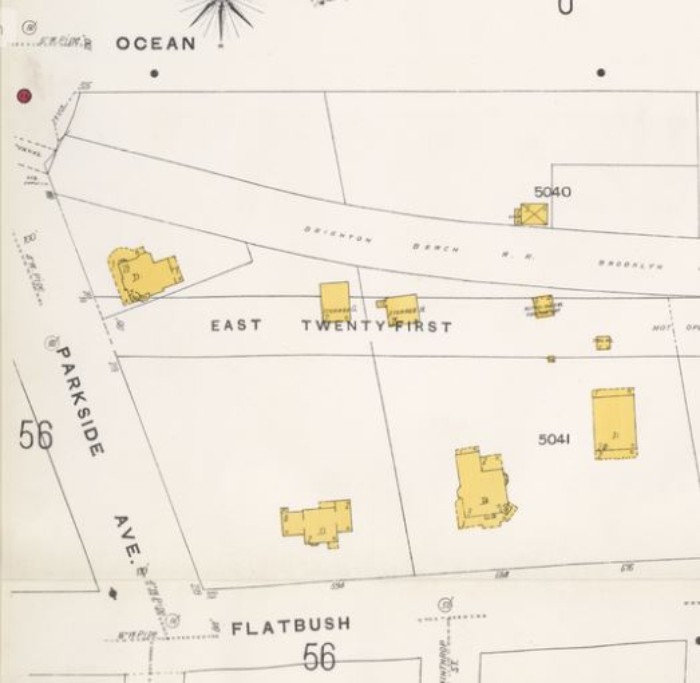
What made the property special was William A.A. Brown’s other great love – horticulture. On the expansive grounds behind his house he had the largest private greenhouse and gardens in Brooklyn.
In 1888, a reporter for the Eagle visited Brown and his garden. He wrote that Brown had several acres of gardens between his house and the house next door, which belonged to his son, also named William A. A. Brown. (Yes, that added to the research confusion.)
Brown had contracted the firm of Lord & Burnham to design and build his conservatory and greenhouses. He had several buildings: a conservatory, a rose house, an orchid house and a show house. They were connected by propagating houses, work rooms and underneath, a boiler house, which regulated the temperatures in the greenhouses.
Brown showed the reporter around his kingdom, and it was beautiful and quite impressive. He had exotic species of plants from all over the world. The conservatory had petrified forest trunks as benches and ferns from the deepest rain forests. He grew rare species of orchids, and had some of the world’s most beautiful roses.
He also had outdoor flower gardens and an orchard with all kinds of fruit trees, a grape arbor and more. His show house had flowers of every kind. He could have supplied flowers for every wedding, funeral and special occasion with the amount of flora present. It was truly spectacular.
Brown was very generous with his gardens. He occasionally opened them up to the public for fundraisers by local charities. He was known to show up at charity dinners with massive amounts of flowers for their displays. He also gave flowers for his friends’ weddings and, when necessary, their funerals.
The society ladies of Flatbush were always glad to see Brown. He could be counted on for donations and for flowers. This generosity went on for many years.
But as the 20th century progressed, Flatbush changed radically. One by one, the old mansions and Dutch farmhouses were torn down for development. Large landowners sold off the farmsteads for houses. The Lefferts family had sold the farm, and Lefferts Manor houses were being built.
Brown was a part of this, developing houses in this neighborhood and further into Flatbush. His days as the grand gardener of Flatbush were ending.
As shown in the 1916 map, he had already sold off the back end of his land for a small row house cul de sac called Parkside Court. The homes’ backyards extended almost to his back porch. By 1923, Brown’s mansion, and all of the private houses on this side of Flatbush, would be gone.
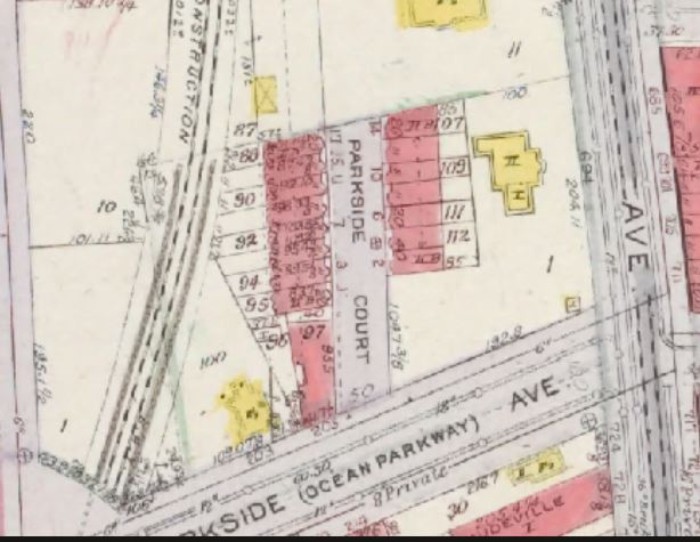
Large apartment buildings would replace them. The huge apartment building now on the corner of Flatbush and Parkside, at 225 Parkside Avenue, part of which stands where Brown’s house once stood, has 126 apartments and 13 commercial tenants. The flowers and greenhouses are long gone.
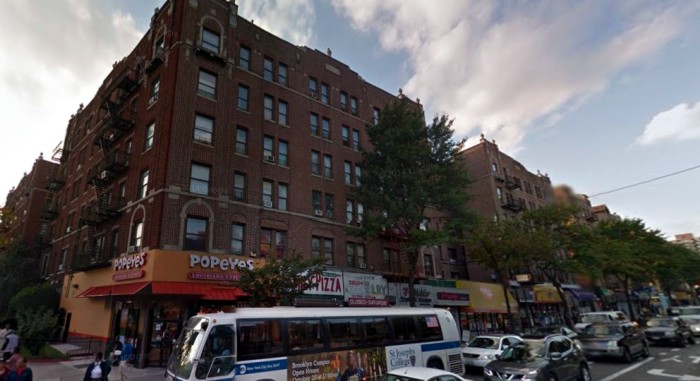









Thank you, M.M…great reads always..I’ve been to BHS dozens of times..dont know how you get this information..awesome stuff
We, FriendsCollective ,would love to be apart of some if not all of your walking tours that you conduct.
what we do in historical based clothing product. my apologizes on getting in contact w/u this way but its been hard to reach you
pls check us out an pls consider
thx A.Lago
FriendsCollective
http://www.friendscollective.nyc/#!look-book–v-neck/c2qv
Terrific article. Thank you. The first map shows East 21st Street running between and parallel to the railway line and Flatbush Avenue. The second, later map shows that thoroughfare as Parkside Court which it is today. Can you shed any light on when and why the change took place. It also seems that E21st Street might have been longer that Parkside Court is today.